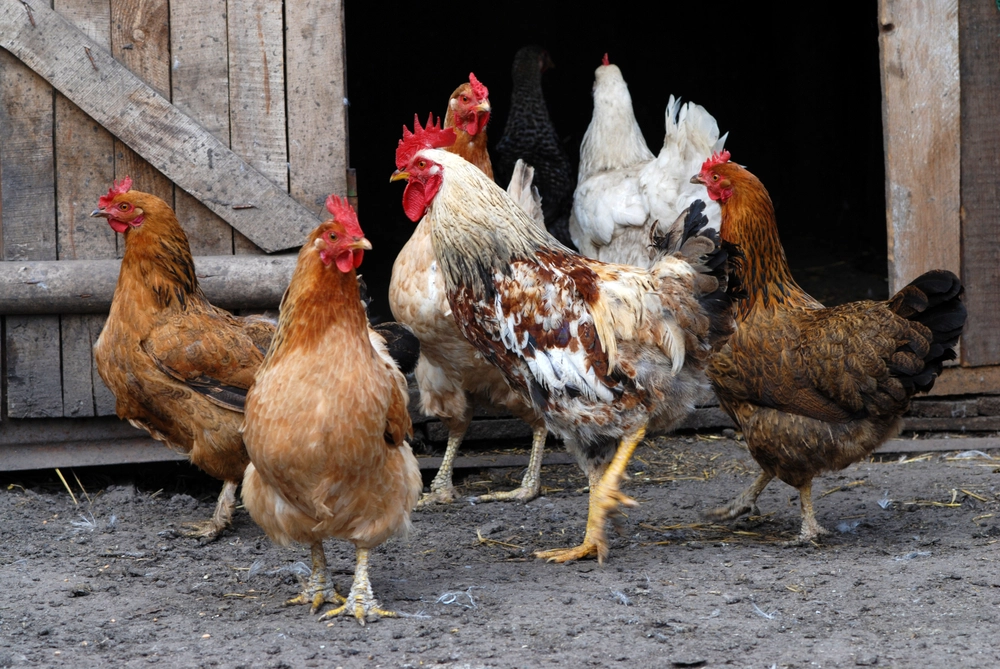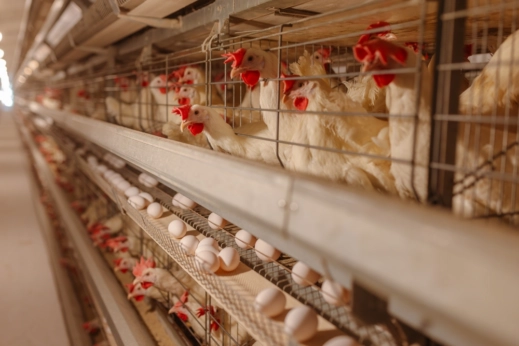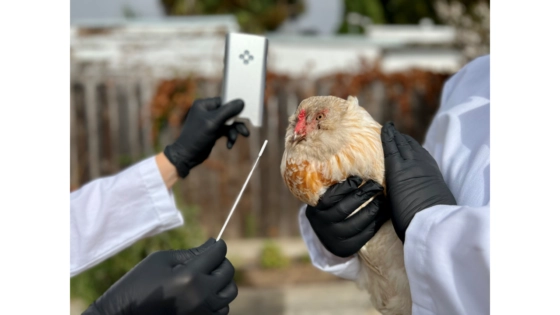With nearly 70 million birds affected, the risk of bird flu throughout North America remains high. Infection rates could continue to rise, so producers are trying to be proactive.

Mandy Melnyk has made some changes to her egg and poultry business in the last few months. The owner of Meadow Creek Farms in northern Alberta serves about 200 families a month with her egg subscriptions and broiler chickens—but now, instead of customers coming to pick up their orders from Melnyk directly, she’s spending a lot of time in the car, delivering them herself.
Like many poultry farmers, Melnyk is worried about Highly Pathogenic Avian Influenza (HPAI), or bird flu. The virus has been plaguing the industry since the 1960s, but the current H5N1 variant first came to prominence in the mid-1990s, when there were large outbreaks in southern China and Hong Kong. This current wave, which started last year, has spread to more than 80 countries. While there are ebbs and flows of disease transmission, the big outbreak that plagued producers in 2022 hasn’t shown signs of slowing yet.
Anybody who comes into your yard is a risk, she says. “[The disease is] so small, it’s like a minute little piece of dust. So, you’re at risk all the time. Anything you do with poultry is truly just a risky kind of business,” says Melnyk. “You have to get really creative, and you have to be on the ball. For me, going directly to people’s houses is the safest way I can keep all sorts of things off my farm.”
Rather than let customers come to her, and potentially infect the birds on her property, Melnyk is going to them, and then disinfecting when she gets back home. It’s part of a stringent biosecurity regime, which gets updated and tweaked as needed. “I have a zillion pairs of different rubber boots. I have rubber boots all over my yard, to use for different areas. My boot management is very good,” says Melnyk. She also uses vinegar and disinfectant as she moves between buildings, and she’s keeping her birds inside more, to ensure they stay away from wild fowl.
Most of those wild birds, including Canada geese, should have left northern Alberta through September and October. But when Modern Farmer reached Melnyk in mid-November, the geese were still there. “This warm spell that we’re having is incredibly frightening, because it slowed down the migration of the geese,” says Melnyk. “We have grass turning green. Dandelions are coming up. I saw birds around that should have been gone four weeks ago.” With the wild birds sticking around, Melnyk is anxious and stressed, finding ways to get her energy out.
“I actually have to run for a few miles every second day in order to function, just because I’m constantly afraid.”

Egg production plant. Photography by Shutterstock.
The anxiety is understandable. There are currently 69 million birds affected with HPAI, in over 47 states, with infections striking commercial barns and backyard flocks alike. The biggest hit so far has been in Iowa, where a commercial egg-laying operation lost 1.6 million birds in late November. While that’s high, representatives from the USDA’s Animal and Plant Health Inspection Service (APHIS) say that we actually saw even more infections last year. “The overall number of birds affected was significantly higher in 2022 than it has been so far in 2023. In fact, we’ve seen 100 cases in commercial poultry facilities so far in 2023, versus 306 in commercial facilities in 2022—a decrease of more than 80 percent to the number of birds affected by the virus in 2023.”
But, surprisingly, these aren’t distinct infection cycles of HPAI. This current wave of bird flu is actually the same wave we were fighting last year; there hasn’t been a full stop when the USDA can declare the outbreak over.
“It’s kind of convenient for us, as morbid as that sounds, because we just keep the response going. We didn’t shut our office down or close the books, and then have to restart everything,” says Michael Cruson, communications director for the Minnesota Board of Animal Health. Minnesota, the turkey capital of the country, has seen more than 600,000 birds hit with HPAI in the past four months.
The last distinct wave of HPAI was in 2014 through to 2015, though APHIS say it’s difficult to compare the two outbreaks. “More than 70 percent of cases during the 2014/2015 outbreak were due to farm-to-farm spread, versus fewer than 20 percent of the cases in this outbreak. The cases in the current outbreak are primarily being introduced directly from wild birds that are carrying the virus to domestic birds,” say representatives from APHIS in an email to Modern Farmer. As infected birds migrate, drinking from shared water sources or leaving stool or urine in shared areas, commercial birds get infected. It makes sense that there would be an upswing in the last month or so, as those birds finally start making their way south.
“Hopefully, this is all leading to a downswing, where we can catch a break from this virus,” says Cruson. “It’s just taking a really long time to get to zero, where it’s gone.”

A chicken getting tested with the be.well. Photography courtesy of Alveo Technologies.
Producers can test regularly for the virus, but the process can occasionally be delayed. The first test in an area, says Cruson, is often done by the state laboratory and then confirmed by the USDA. That means there can be a wait of a day or two, where the virus may be present in an operation, but state agencies aren’t able to take action without federal approval. That’s a fairly reactive model, says Shaun Holt, who is encouraging a transition to a more preventative process.
Holt is the CEO of Alveo Technologies, a testing and diagnostics company that’s currently finalizing its initial testing of the Alveo Sense, a device that allows farmers and producers to do initial testing on site. “We want to take the testing out of the lab, where it’s centralized, and you need PhD scientists to run the instruments,” says Holt. Its device, slightly smaller than a smartphone, is portable and rugged, so farmers can slip it in their pocket and bring it with them on their daily rounds. There are eight different testing wells, where producers can test samples collected from the trachea or cloaca.
The device enables geolocation, and farmers can input data such as the exact coop number and flock to keep track of which viruses are showing up where and maintain a log for state or federal databases. In 2024, the company hopes to expand the testing phase to more commercial customers. The goal, says Holt, is to decentralize that testing model and allow farmers to see what’s happening in their flocks faster.

The Alveo Sense device. Photography courtesy of Alveo Technologies.
Until then, the best thing producers can do is be strict with bio-security, says Dustan Clark, poultry health veterinarian for the University of Arkansas. He recommends “putting up the birds in a pen that’s roofed over, even if it’s as simple as a plastic tarp on top, to help prevent contamination from wild bird droppings. If you’ve got a pond on your premises, make sure your birds don’t go near that pond, and don’t go near the pond yourself.” Be sure to clean and disinfect shoes before going into a coop, but the best thing to do is avoid areas such as parks, where wild birds congregate, he says. Above all, pay attention to your birds. Look at how much feed they’re eating, how much water they’re drinking, how many eggs they’re laying. If things look off, trust your instinct. “We call it ADR: Ain’t Doing Right,” says Clark. “And as a producer, you know when your birds just aren’t doing right.”
As we go into the winter season, it stands to reason that cases will drop as wild bird migration wraps up, and Clark is hopeful that’s the case. “Are we going to be dealing with it in the spring? We just don’t know at this time. Almost anybody’s guess.”
For Mandy Melnyk, spring migration is a long way off, but the health and safety of her birds is always on her mind. While she’s heard of the HPAI vaccine, it could be a while before that treatment is readily available to her. Instead, she is preparing to deal with an increased risk of bird flu going forward. “I think that climate change, and the migratory patterns of our birds changing, is a problem that nobody will fix, unless everybody pays attention.”
Go vegan. Raise chickpeas.
It’d be good to interview Polyface Farms’ Joel Salatin for another perspective on this disease. He’s got a much more holistic view, not fueled by fear, but by common sense.
Clearly the many biosecurity measures are working and there other good news too. The downside is that this threat will persist for possibly many years. There can be incremental improvements, but H5N1 is circulating almost worldwide now, in millions of birds.